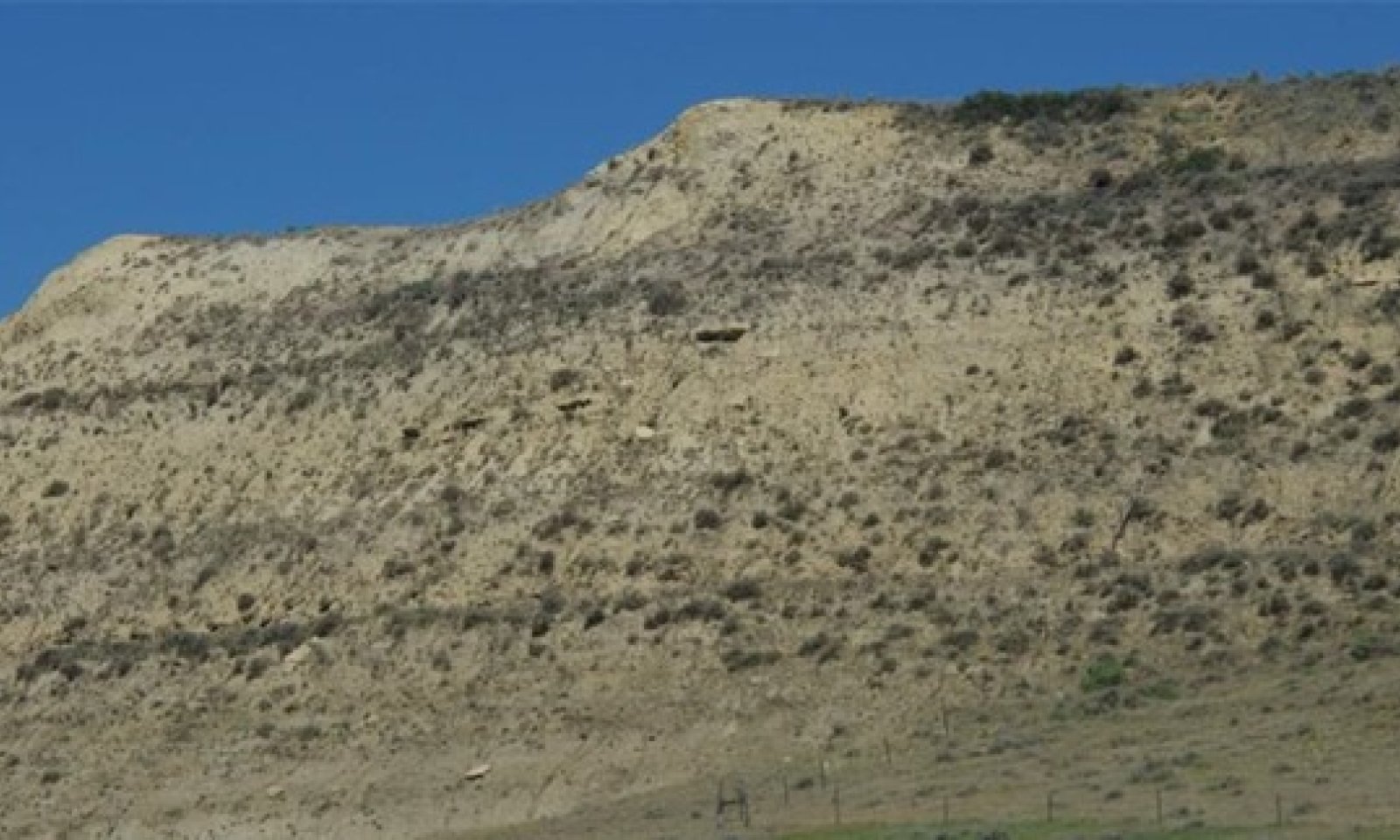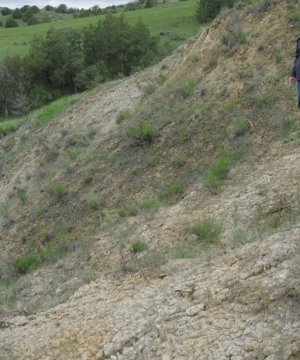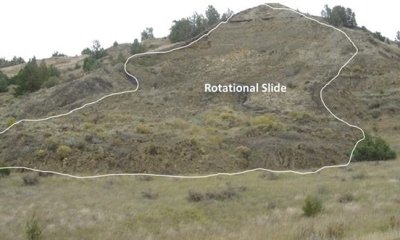
Badland
Scenario model
Current ecosystem state
Select a state
Management practices/drivers
Select a transition or restoration pathway
-
Transition T1A
Colonization by exotic cool-season grasses
More details -
Transition T1B
Rotational slide
More details -
Transition T2A
Rotational slide
More details -
No transition or restoration pathway between the selected states has been described
Target ecosystem state
Select a state
Description
This state represents the natural range of variability that dominated the dynamics of this ecological site prior to European influence. The primary disturbance mechanism for this site in the reference condition is rotational slides (aka slumping). Due to steepness of slope, precipitation events, fires, hydrology, bedrock/parent material (e.g., lignite veins), soil conditions/development, and other factors, this ecological site is subject to rotational slides. These rotational slides appear to be more frequent on the north and east facing slopes with fire followed by major precipitation events being a major contributing factor. Wildfires may serve as triggers for future slides due to changes in vegetation, soil conditions, hydrology, and other factors. As a result, care should be given to identify any rotational slides, as well as whether the slide has resulted in a change in states and community phases or perhaps ecological site(s). These factors largely dictate the dynamics that occur within the natural range of variability which likely cause the community to shift both spatially and temporally between two community phases.
Due to the variations in soils, aspect, and other factors, bare ground is extensive with vegetation typically sparse and widely scattered. However, it may include a wide variety of plants.
Characteristics and indicators
No invasive exotic plants present. Presence of non-invasive species (e.g., sweet clover), however, does not signify a transition to State 2: Native/Invasive State.
Resilience management
If intact, the reference state should probably be managed with current disturbance regimes which has permitted the site to remain in reference condition, as well as maintaining the quality and integrity of associated ecological sites. Maintenance of the reference condition is contingent upon a monitoring protocol to guide management.
Submodel
Description
This state is similar to State 1: Reference State but has now been colonized by the exotic cool-season grasses (commonly smooth brome, and/or crested wheatgrass) which are now present in small amounts. Other exotic species (e.g., leafy spurge, Canada thistle, sweetclover) may also be present.
Characteristics and indicators
The presence of trace amounts of exotic cool-season grasses indicates a transition from State 1 to State 2. Canada thistle and leafy spurge are also known to invade the site. The presence of exotic biennial or perennial leguminous forbs (e.g., sweet clover, black medic) may not, on their own, indicate a transition from State 1 to State 2 but may facilitate that transition.
Resilience management
Due to steepness of slope and sparse vegetation, prescribed grazing and prescribed burning are generally not viable options. Management of adjacent ecological sites is an important factor in slowing or limiting the invasion of exotic plants.
Submodel
Description
This state results from a rotational slide (aka slump). The sliding mass may stay intact, thus resulting in relatively small changes in site conditions. However, it may also break up into portions of different sizes and settle out in different orientations. Often, much of the vegetation present before the slide continues growing after being relocated by the slide. The result is a mosaic of various sized segments that can markedly differ in soil characteristics, aspect, areal extent, existing vegetation, and other factors. Over time, different ecological sites may develop. As such, care should be given to identify any rotational slides, as well as whether the slide has resulted in a change in states, community phases, or perhaps ecological site(s).
Characteristics and indicators
The presence of a rotational slide characterizes this Rotational Slide/Mosaic State.
Resilience management
Due to steepness of slope and sparse vegetation, prescribed grazing and prescribed burning are generally not viable options. Management of adjacent ecological sites is an important factor in slowing or limiting the invasion of exotic plants.
Submodel
Mechanism
This is the transition from the State 1: Reference State to the State 2: Native/Invaded State due to the introduction and establishment of exotic cool-season grasses (typically smooth brome, and/or crested wheatgrass). This transition is probably inevitable. The threshold between states is crossed when smooth brome, crested wheatgrass, or other exotic species become established on the site.
Constraints to recovery
Current knowledge and technology will not facilitate a successful restoration to Reference State.
Mechanism
This is the transition from the State 1: Reference State to the State 3: Rotational State/Mosaic State results from a rotational slide (aka slump). The sliding mass may remain intake resulting in relatively small changes in site conditions or break up into portions of different sizes and settle out in different orientations resulting in a mosaic of various segments that can markedly differ in soil characteristics, aspect, vegetation, and other factors.
Constraints to recovery
Current knowledge and technology will not facilitate a successful restoration to State 1: Reference State.
Mechanism
This is the transition from the State 2: Native/Invaded State to the State 3: Rotational State/Mosaic State results from a rotational slide (aka slump). The sliding mass may remain intact resulting in relatively small changes in site conditions or break up into portions of different sizes and settle out in different orientations resulting in a mosaic of various segments that can markedly differ in soil characteristics, aspect, vegetation, and other factors.
Constraints to recovery
Current knowledge and technology will not facilitate a successful restoration to State 2: Native/Invaded State.
Model keys
Briefcase
Add ecological sites and Major Land Resource Areas to your briefcase by clicking on the briefcase (![]() ) icon wherever it occurs. Drag and drop items to reorder. Cookies are used to store briefcase items between browsing sessions. Because of this, the number of items that can be added to your briefcase is limited, and briefcase items added on one device and browser cannot be accessed from another device or browser. Users who do not wish to place cookies on their devices should not use the briefcase tool. Briefcase cookies serve no other purpose than described here and are deleted whenever browsing history is cleared.
) icon wherever it occurs. Drag and drop items to reorder. Cookies are used to store briefcase items between browsing sessions. Because of this, the number of items that can be added to your briefcase is limited, and briefcase items added on one device and browser cannot be accessed from another device or browser. Users who do not wish to place cookies on their devices should not use the briefcase tool. Briefcase cookies serve no other purpose than described here and are deleted whenever browsing history is cleared.
Ecological sites
Major Land Resource Areas
The Ecosystem Dynamics Interpretive Tool is an information system framework developed by the USDA-ARS Jornada Experimental Range, USDA Natural Resources Conservation Service, and New Mexico State University.




